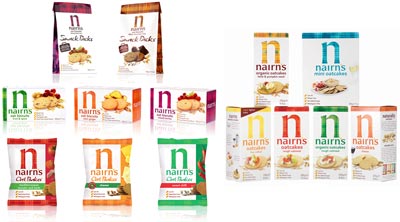Wheat Free Living by Nutritionist and Dietician Fiona Hunter
March, 2010

This article has been provided to wheat-free.org by nairn's
oatcakes, manufacturers of wheat free Scottish oatcakes.
A growing number of people are finding that cutting down on wheat can be the answer to niggling health problems. Fortunately there are lots of very good wheat free products available these days, so wheat free living doesn’t have to mean missing out on your favourite foods
Case Study 1
Gill Jacobs cut wheat out of her diet about six years ago. “My weight had been creeping up over a number of years and I decided I had to do something about it”, says Gill, 61, who runs a small business in London. "So a friend, who is a naturopath, gave me a weight loss programme which involved cutting out wheat and other carbs. I was really surprised by how easy it was to stick to the diet and how quickly the weight dropped off – within four weeks I’d lost one stone.
"After the first month I gradually started to include carbs like rice and other grains back into my diet, although I continued to avoid wheat. Although I continued to lose weight it took a bit longer to come off but within three months I’d lost two stone. As well as being slimmer I felt fantastic and had loads of energy. Although I eat more carbs now, I’ve continued to avoid wheat because I just don’t think it agrees with me, although I can seem to tolerate small amounts so I will eat bread and pasta when I’m out.
"For breakfast I usually have a smoothie or home-made granola, if I’m hungry mid-morning I have a boiled egg or a couple of oatcakes. I like to have my main meal at lunch time so I usually have something like lean meat or fish with pulses, rice or quiona, and then in the evening some home-made soup".
Case Study 2
The forties were proving far from fabulous for Anna Toller. A 41 year old working mum, Anna was suffering from fatigue, headaches and severe digestive track problems on a daily basis. Some days she was constipated and other days she suffered from debilitating diarrhoea. She ran her own business and illness was having a negative effect on both her work and home life. She knew something was wrong, so she consulted her GP. Anna’s doctor diagnosed Irritable Bowel Syndrome. In addition to being advised to take oil of peppermint pills to help control the symptoms, her doctor suggested Anna tried excluding various food groups from her diet to see if her symptoms improved.
After discussing the problem with a complementary health practitioner Anna was advised to exclude all wheat and yeast from her diet. This meant avoiding bread, pasta and products made with wheat, as well as cheese, mushrooms and wine because of their yeast content. In addition Anna was given a course of probiotic supplements to help to eliminate the bad bacteria and replenish the good bacteria in her digestive tract.
For Anna there was light at the end of the tunnel. Her health practitioner was able to trace the likely cause back to the many high doses of post-operative antibiotics she was given following illness and emergency surgery in her twenties and thirties. The practitioner believed these had created imbalances in her intestines which have only now been corrected. After nine months on the diet Anna was clear of symptoms and was able to gradually re-introduce favourite foods back into her diet. Although she now eats a normal diet she tries to avoid eating too much wheat and is more aware of eating a wider variety of different grains and cereals such as oats and rye. Anna now incorporates into her current daily diet many foods that she enjoyed as alternatives to wheat during her recovery process such as oatcakes and rice cakes.
Foods to avoid
- Wheat, flour and all foods made with flour (bread, pizza, pasta, cakes, biscuits, crackers, pastry, batter)
- Semolina, couscous, spelt, bulgur wheat, kamut
- Breakfast cereals containing wheat, wheat germ or wheat bran
- Breadcrumbs and foods like sausages or fish cakes, that contain breadcrumbs
- Sauces and gravies thickened with flour
- Many processed foods and manufactured goods contain flour as a thickening agent or filler so it is essential to check the label on individual products
- Avoid products containing the following ingredients: bran, cereal binder, cereal filler, starch, cereal protein, modified starch, edible starch, food starch, flour, rusk, rye, vegetable protein, wheat flour, wheat germ
Foods and ingredients which may contain wheat
- Gnocchi
- Soy sauce
- Stock cubes
- Dumplings
- Meatballs
- Taramasalata
Substitute: Wheat free grains, flour and carbohydrates:
- Rice
- Potatoes
- Barley
- Buckwheat
- Quiona
- Polenta (cornmeal)
- Rice, soba, udon or buckwheat noodles
- Millet
- Wheat free bread or bread mix
- Rice, potato, soya, rye, corn (maize) or chickpea flour
- Arrowroot, cornflour, sago or tapioca
- Cornflakes, rice crispies, ricicles, porridge, wheat free muesli
- nairn’s Oatcakes, rice cakes
- nairn’s Oat Biscuits
- nairn’s Oat Bakes, rice crackers
- Wheat free pasta
- Popcorn
- Rye bread pumpernickel and rye crisp bread
- Taco shells
- Corn tortillas (check ingredients list - not all makes are wheat free)
- Rice bran
Tips for wheat free living
- If you’re planning to eat out, contact the restaurant at least a couple of days before your visit. Ask them to fax or email a copy of their menu to you so you can check that they have suitable dishes. Provide them with a written list of what you can and can’t eat.
- Making wheat free bread at home works out much cheaper than buying ready made, so think about investing in a bread maker - some models have a special setting for wheat and gluten free breads.
- Products labelled gluten free are not necessarily wheat free because they may contain wheat starch (gluten is a protein and people with a gluten intolerance don’t have a problem with the starchy part of the grain).
- Spelt is an ancient variety of wheat and has a very similar nutritional profile to wheat. Like wheat it contains gluten so it isn’t suitable for people with coeliac disease, although some people who suffer from wheat intolerance find they can tolerate products made with spelt flour.
- Despite its name, buckwheat is not botanically related to wheat. It is gluten free and can usually be tolerated by people who are allergic to wheat, barley, rye and similar cereals. The seeds of the buckwheat plant are available raw or roasted, (known as kasha). They can be cooked (1 part buckwheat to 2 parts water for 6 minutes, then leave to stand for 6 minutes) and served like rice, or you can add it to stews and casseroles. Buckwheat flour can be added to cakes, muffins, pancakes etc. where it imparts a distinctive flavour. Look out too for buckwheat spaghetti and soba noodles which are made from buckwheat.
7 day menu plan
| Breakfast | Snack | Lunch | Snack | Evening meal |
| Sunday | ||||
| Glass of fruit juice Scrambled eggs on wheat free toast |
Oatcakes with hummus and vegetable crudities | Roast chicken, roast vegetables with soft polenta Lemon sorbet with fresh berries |
||
| Monday | ||||
| Glass of fruit juice Banana porridge |
Fruit smoothie | Bowl of lentil soup with 2 oatcakes spread with low fat soft cheese | Yogurt | *Stir fried chicken with rice noodles Fruit salad *Soy sauce often contains wheat. Tamari is wheat free |
| Tuesday | ||||
| Small glass of fruit juice Wheat free muesli with fresh berries and semi skimmed milk |
Banana | Jacket potato with tuna and sweetcorn | Packet of nairn’s Oat Bakes | Mushroom risotto Yogurt with fresh fruit |
| Wednesday | ||||
| Glass of fruit juice Oat biscuit cereal with semi skimmed milk |
nairn’s Oat Biscuits | Roast chicken with mixed bean salad Fruit salad |
Fruit | Grilled salmon, new potatoes and broccoli Greek yogurt with berries |
| Thursday | ||||
| Small glass of fruit juice Oat biscuit cereal with blueberries and semi skimmed milk |
Banana | Salad with pearl barley, feta cheese and tomatoes | Small packet of popcorn | Gluten free pasta with prawns and a spicy tomato sauce |
| Friday | ||||
| Glass of fruit juice Porridge with blueberries |
Oat biscuits | Wild rice salad with avocado and prawns Yogurt |
Oatcakes topped with hummus | Pizza made using wheat free pizza bases, with salad Ice cream or frozen yogurt |
| Saturday | ||||
| Glass of fruit juice Boiled egg Wheat free toast with marmalade or jam |
Yogurt | Tomato and barley soup Fruit |
Packet of Oat Bakes | Lasagne made with wheat free pasta, with green salad Fruit salad |
Cooking with wheat free flour
There are several varieties of wheat free flours available in most health food shops but unfortunately unlike wheat flour there isn’t one that suits all purposes. If you don’t do much baking you are probably better off buying one of the commercially blended wheat free flours. However if you do enjoy cooking you may enjoy experimenting with other types of flour. Certain types of flour are better suited, as follows:
- Rice flour and ground rice - available as brown or white rice flour, can be used to bake biscuits
- Potato flour - also called potato starch or farina - works well in baked goods and is an excellent thickening agent.
- Soya flour - an excellent source of protein and B vitamins. It has a strong flavour and is therefore best used in combination with other flours
- Cornflour or cornstarch - a good thickening agent, it can also be used to make cakes, bread and biscuits
- Chickpea flour (also called gram flour or Besan flour) - widely used in Indian breads and batters, like soya flour it is a good source of protein and vitamins. It has a strong flavour but will go bitter if kept for too long
- Arrowroot - an excellent thickening agent useful for gravies and sauces
- Chestnut flour - has a distinctive flavour but can be used for baking cakes and biscuits
- Sago flour - has very little flavour and a similar to rice flour in texture, it can be used for puddings and for thickening stews
- Tapioca - like sago it is almost pure starch it can be used by itself to make puddings or used to thicken soups or stews
- Buckwheat flour - has a strong distinctive flavour. It is best mixed with other wheat free flours
What is the difference between wheat allergy and wheat intolerance?
Many people assume that wheat allergy and wheat intolerance are the same thing and although in many cases the symptoms can be the same, allergy and intolerance are quite different.
Wheat allergy occurs when the body reacts to the protein in wheat and releases IgE antibodies in response. Symptoms typically occur within 2 hours of eating wheat and can include:
Skin symptoms – hives/rash itching, atopic dermatitis
Digestive symptoms – swelling of the lips or tongue, abdominal
crabs, vomiting, diarrhoea, bloating
Respiratory symptoms – itchy runny nose and eyes, asthma
People with food allergy usually react to even minute amounts of the food in question.
The mechanism which causes wheat intolerance is not fully understood, as intolerance does not involve the immune system. Symptoms often occur after a longer period of time and are usually less severe than with a food allergy. Many people with wheat intolerance can tolerate small amounts of wheat.
Download Wheat Free Living By Nutritionist and Dietician Fiona
Hunter [PDF]


